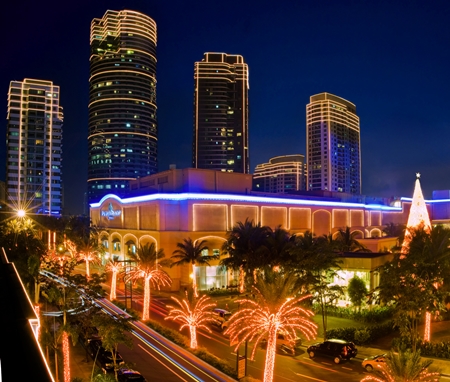Strong demand from local and multinational companies and the continued evolution of the Business Process Outsourcing industry may propel the Philippine office property market to become one of the major markets in the Asia Pacific region in the next few years, according to property management company Jones Lang LaSalle.
Phillip Anonuevo, associate director of Jones Lang LaSalle in Manila, observed that while corporate offices previously accounted for only 10 per cent of office space leased, this segment is expected to grow by as much as 20 per cent as multinational companies prepare to upgrade their office facilities. In addition, if demand from corporate offices continues, take-up of office space could reach 450,000 square meters annually for the next two years. Anonuevo remarked: “We haven’t seen this kind of office activity since the 1990s.”
 Makati skyline. (Photo/Wikipedia)
Makati skyline. (Photo/Wikipedia)
He observed that many new multinational companies were making investments in local firms and consequently seeking better quality office space. Figures from the Business Processing Association of the Philippines (BPAP) likewise indicated that office demand was further strengthened by the growing number of “captives” or offshore operations owned by multinationals, as opposed to offshore operations outsourced by multinationals to third-party vendors such as BPOs.
According to Claro Cordero, Jr., JLL head for research, consulting and valuation, the Philippine offshoring and outsourcing (O&O) industry accounted for US$11 billion in 2011 according to the BPA/P and could grow to as high as US$25 billion in 2016.
Cordero also emphasized that the mid-end residential sector, comprised of units from Php50,000 to Php110,00 per sqm, is far from reaching an over-supply situation. He disclosed that 154,000 units are projected to be built out from 2012 up to 2016 which is 30 per cent more than the 118,000 units built from 1999-2011.
“Nevertheless, the timetables for completion of these projects are highly elastic. Moreover, Metro Manila’s estimated daytime population of 14 million, as opposed to its nighttime population of around 10 to 11million, indicates that demand for mid-end residential units is far from being fully served,” he said
Cordero also pointed out that tourism is projected to shore up the economy and the real estate sector up to 2015. He disclosed that developments that accounted for 10,536 rooms, to be completed between 2012 and 2015, have been launched. Projects amounting to another 3,600 rooms mostly within Entertainment City in Paranaque have also been announced but with no completion dates specified.
Just as tourism is expected to transform Metro Manila, the office sector will also reshape the urban landscape. Anonuevo observed that, currently, Makati accounts for 53 percent of prime and grade A office stock with Ortigas coming in second at 25 percent and Bonifacio Global City at six percent. A number of other emerging districts like Bay City and Quezon City account for less than three percent.
Future pipeline supply from 2012 to 2015 will fuel the growth of business districts besides Makati CBD. Bonifacio Global City will capture as much as 41 percent of the new office stock in addition to its many attractions, while Quezon City will account for 15 percent, Makati 11 percent and Ortigas 10 percent.




